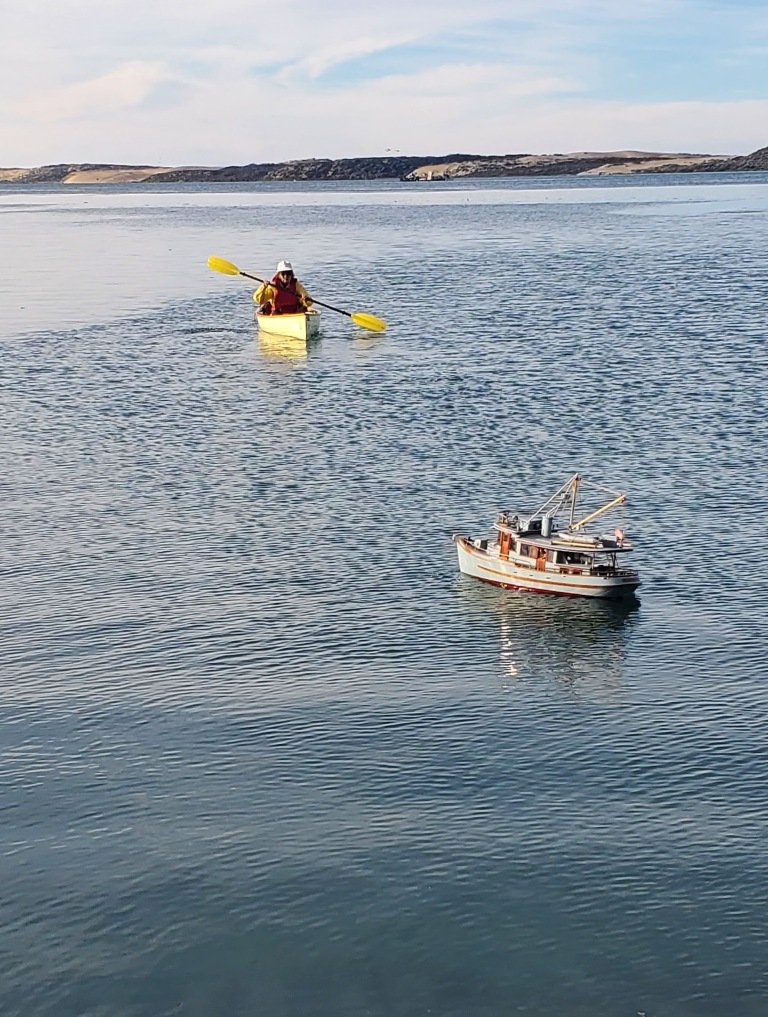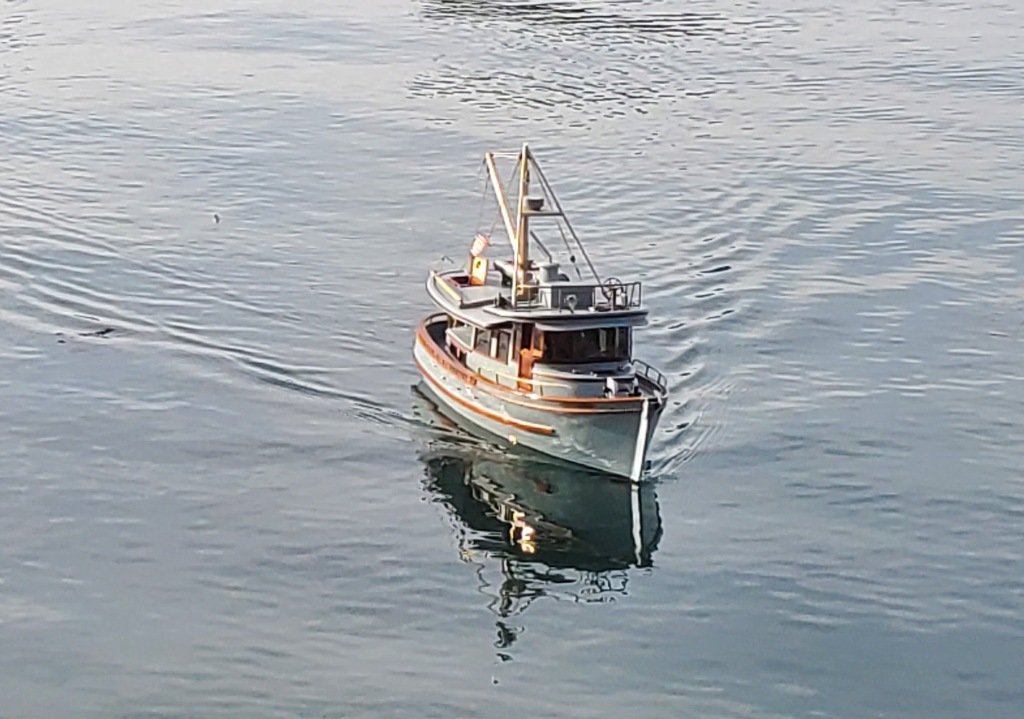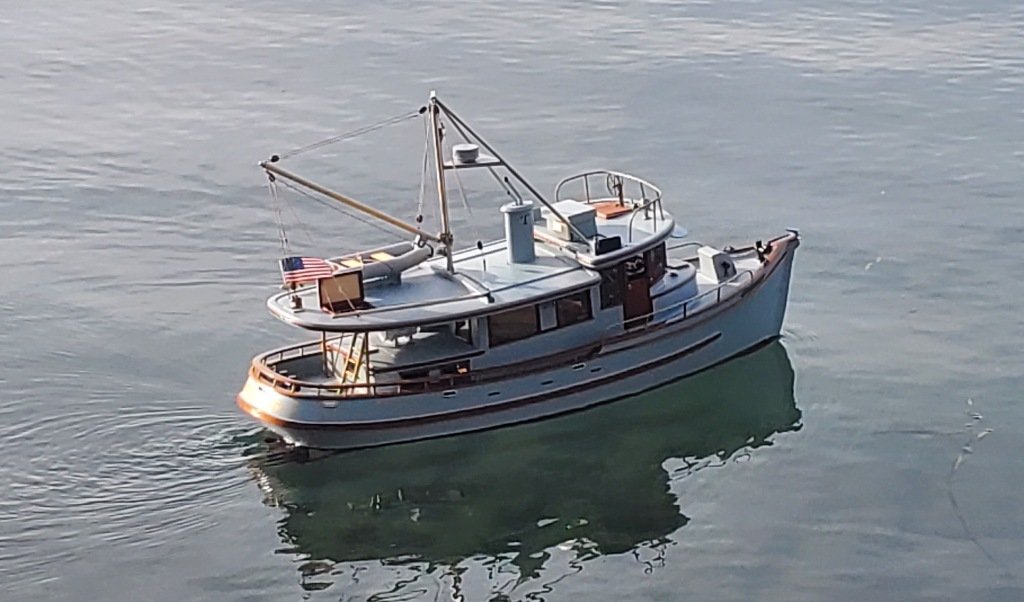-
Posts
162 -
Joined
-
Last visited
Content Type
Profiles
Forums
Gallery
Events
Everything posted by MAGIC's Craig
-
Hi, Sal: Your model is progressing well and with very nice detailing! I note that you are running the same motor/ESC combination as I have in TWILIGHT. I would heartily recommend -if you have not yet done it - to do the "Transmitter-to-ESC-to-motor" calibration before you get her into the water again. I found out the hard way that missing this step may lead to the motor going full speed on the very first notch of the throttle and the poor boat trying to emulate PT-109. Twilight ended up surging forward nearly out of control and finally rolling onto her port side leading to downflooding. Fortunately, my wife was able to grab TWILIGHT before she sank, but as a result of the swamping, the electronics below deck had to be replaced. ***** (From my post #113 - "TWILIGHT was placed in the water from a local kayak launch ramp after we had first launched Vicky in her canoe to be the "rescue" craft in case of need. When I gave the throttle control on the transmitter a slight nudge to the first detent of forward, TWILIGHT's stern suddenly dropped down in a swirl of bubbles, the bow popped way up, the sudden torque from the prop heeled her over to port and she shot forward, wildly swerving to starboard. This little displacement trawler yacht was trying to emulate PT-109 😲 I jerked the throttle back to neutral while trying to straighten out her course and she coasted to a wobbly stop. Obviously, something was not right and so, I tried to nurse her back around to head to the launch ramp. However the pulses of power, brief as they were, set up a surging oscillation, rolling the model from side to side. I was "behind the curve" with the rudder actions and TWILIGHT ended up broaching to port onto her beam ends and began down-flooding. By the time Vicky could get to TWILIGHT and grab the cabin top, she was awash. TWILIGHT did not sink and was able to be brought to shore to be emptied out with a minimum of exterior damage. The electronics were, unsurprisingly, "toast" and all had to be discarded. It took a number of days to dry out TWILIGHT and I spent some time this discussing the odd throttle behavior with Nick Scalone, of Harbor Models. Ultimately, we were able to focus upon my failure at that time to re-calibrate the transmitter to the electronic speed control unit which governs how much juice to feed the motor. This left the ESC in a default mode and it went instantly to full throttle. (The joys of electric motors.) New replacement components were ordered, installed and, most-importantly, repeatedly bench-tested." With the current now-calibrated replacement electronics, TWILIGHT enjoys a more sedate and controllable speed. ***** If you were smarter than I and have already accomplished the calibration, then please feel free to disregard this suggestion. 😉 <And I second Ian's sound recommendation!> Craig
- 62 replies
-
- Nordkap
- Billing Boats
-
(and 1 more)
Tagged with:
-
We were lucky enough to visit ARGONAUT II some years ago under a previous owner. Her Gardner is a sweet sounding engine. Also, the former Mission hospital ship, COLUMBIA III, running with a gleaming 60+ year old 8L3 Gardner, still works under the careful custodianship of Ross Campbell as a Mothership for kayak trips in the northern BC waters. I believe that Nick is currently cruising as crew with Leo Goolden on TALLY HO making the passage down the Mexican West coast to Panama. It is a surprisingly close bunch of folks who manage to keep these old girls running. TWILIGHT probably would have fit right in.
-
So, the initial "sea trial" in late October was an "interesting" learning experience. TWILIGHT was placed in the water from a local kayak launch ramp after we had first launched Vicky in her canoe to be the "rescue" craft in case of need. When I gave the throttle control on the transmitter a slight nudge to the first detent of forward, TWILIGHT's stern suddenly dropped down in a swirl of bubbles, the bow popped way up, the sudden torque from the prop heeled her over to port and she shot forward, wildly swerving to starboard. This little displacement trawler yacht was trying to emulate PT-109 😲 I jerked the throttle back to neutral while trying to straighten out her course and she coasted to a wobbly stop. Obviously, something was not right and so, I tried to nurse her back around to head to the launch ramp. However the pulses of power, brief as they were, set up a surging oscillation, rolling the model from side to side. I was "behind the curve" with the rudder actions and TWILIGHT ended up broaching to port onto her beam ends and began down-flooding. By the time Vicky could get to TWILIGHT and grab the cabin top, she was awash. TWILIGHT did not sink and was able to be brought to shore to be emptied out with a minimum of exterior damage. The electronics were, unsurprisingly, "toast" and all had to be discarded. It took a number of days to dry out TWILIGHT and I spent some time this discussing the odd throttle behavior with Nick Scalone, of Harbor Models. Ultimately, we were able to focus upon my failure at that time to re-calibrate the transmitter to the electronic speed control unit which governs how much juice to feed the motor. This left the ESC in a default mode and it went instantly to full throttle. (The joys of electric motors.) New replacement components were ordered, installed and, most-importantly, repeatedly bench-tested. On December 3rd, everything came back together (boat, tides, weather and our schedules) to permit Sea Trial #2. Once again, we launched Vicky in her canoe, did one more pre-launch systems check and then placed TWILIGHT in the water. This time, things went much better. (Photos courtesy of Larry Bender) Though the sea trial was shortened by a strengthening wind, I was able to verify TWILIGHT's basic running gear capabilities (and limitations) through a series of maneuvers. While she is nearly complete topsides, I plan to build out the main cabin joinery modules this winter. The future may also involve removing (2) of the (4) 12 vdc sealed lead batteries and utilizing that weight savings to place a couple of small streamlined lead ballast "pancakes" alongside the keel on the exterior of the hull to provide additional stability when turning. We'll see whether that comes to pass and, if so, whether it turns out to be useful. I must relate that I am truly looking forward to returning to the model shop to make sawdust again after these weeks of wiring and tweaking electrical widgets. Until the next update, my thanks again for checking in on our progress. Craig
-
Well done making that prop, Mark. FWIW, we had the 2-blade versions on our boats and they were indeed slippery when feathered. The MaxProp versions we had did require the shaft rotation to change direction in order to completely rotate the blades so that the leading edges were "facing into" the proper orientation for the boat's heading. When one shut down the motor, (and if one was moving through the water sufficiently), the props would then feather into a fore-and-aft configuration for minimum drag. However, those flat blades do give up about 10% in thrust when compared to blades with non-flat sections. Most of the time, that loss of a certain amount of thrust was not a problem. Craig
-
Keith: I came close to just letting that be the case by placing her up on a shelf. However, as has often been the case over our years together, Vicky came out to the shop and asked me to explain what wasn't working to prevent the prop from spinning. I rumbled off about recalcitrant R/C components refusing to do what I understood to be their individual functions as a system, (i.e. "A" plugging into "B" which was in turn to plug into "C" and permit signals to go on to the electronic speed control "D" to spin the motor "E" at the correct rpms.) Somewhere in that sequence something was interrupting it all. I had checked all of the connections and joints, re-read the instructions, freshly charged the batteries, etc, but - nada! So, it was time to give it all a rest. And, as usually happens during the night, a couple of days later, the back brain started hammering on the door to the front brain, saying something along the line of, "Hey, fool, try switching this lead to the receiver and simply delete "B" in the series" (Well, of course it can't be that simple....can it? It doesn't show that in the one-size-fits-all instructions...) But, I gave it a try. Lo and behold, we now have a smoothly functioning throttle and a prop which does not go only all out or not at all! After the upcoming Thanksgiving break, we will take TWILIGHT back over to the bay to continue her sea trials. She will no longer have the sound module making her sound like she's being pushed by a slow-turning Gardner diesel, but she should be able to move at a proper (sedate) pace under control (rather than rearing up out the water, trying to imitate PT-109). (Perhaps more than you wanted to know? 😉 Cheers, Craig
-
Thank you, KeithAug. Your works serve as inspirations for all of us. As it happened, the "Sea Trials" mentioned above, did not go as hoped for and the last month has been spent repairing minor damages and replacing all of the R/C components. I will be writing up a new posting over the course of the next couple of days to bring the blog up to date now that TWILIGHT is once again ready to go. A sometimes challenging hobby we pursue...
-
Great fun to watch your progression as well as admiration for the craftsmanship at this wee scale. Thanks for your frequent posting to keep the lot of us enthralled, Keith. I also quite enjoy seeing both projects together. Craig
- 457 replies
-
- sternwheeler
- Hard Coal Navy
-
(and 1 more)
Tagged with:
-
Beautifully executed, well-photographed and frankly, absolutely stunning precision. Thank you for sharing these photos and techniques with all of us.😲 Craig
About us
Modelshipworld - Advancing Ship Modeling through Research
SSL Secured
Your security is important for us so this Website is SSL-Secured
NRG Mailing Address
Nautical Research Guild
237 South Lincoln Street
Westmont IL, 60559-1917
Model Ship World ® and the MSW logo are Registered Trademarks, and belong to the Nautical Research Guild (United States Patent and Trademark Office: No. 6,929,264 & No. 6,929,274, registered Dec. 20, 2022)
Helpful Links
About the NRG
If you enjoy building ship models that are historically accurate as well as beautiful, then The Nautical Research Guild (NRG) is just right for you.
The Guild is a non-profit educational organization whose mission is to “Advance Ship Modeling Through Research”. We provide support to our members in their efforts to raise the quality of their model ships.
The Nautical Research Guild has published our world-renowned quarterly magazine, The Nautical Research Journal, since 1955. The pages of the Journal are full of articles by accomplished ship modelers who show you how they create those exquisite details on their models, and by maritime historians who show you the correct details to build. The Journal is available in both print and digital editions. Go to the NRG web site (www.thenrg.org) to download a complimentary digital copy of the Journal. The NRG also publishes plan sets, books and compilations of back issues of the Journal and the former Ships in Scale and Model Ship Builder magazines.









